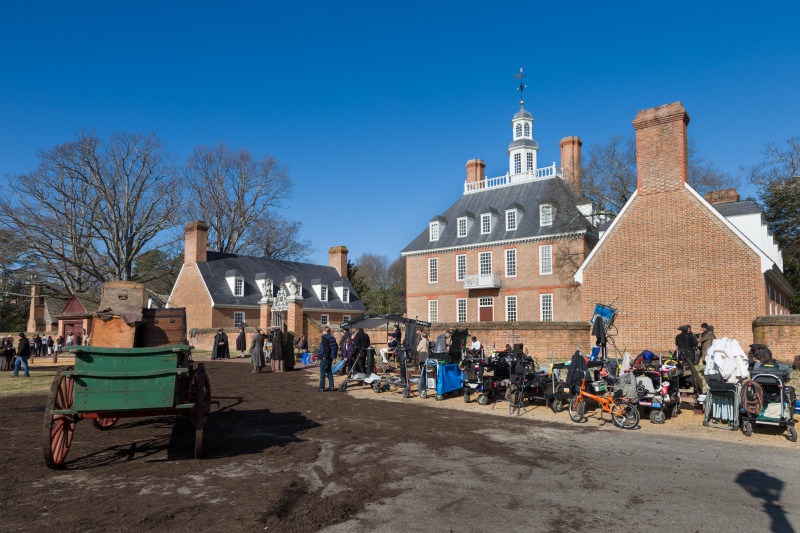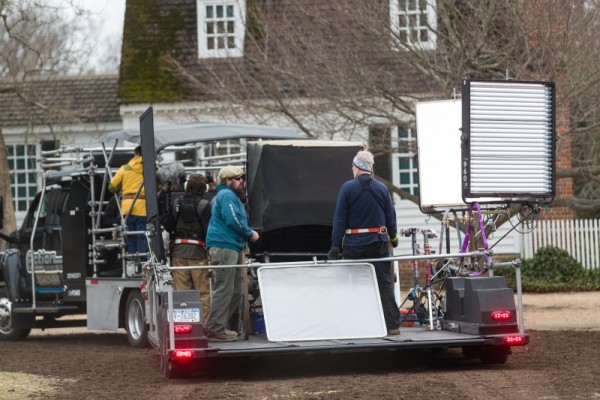Scores of visitors to Colonial Williamsburg’s Historic Area witnessed history Monday as AMC’s spy drama TURN returned for a final day of filming.
The Governor’s Palace was the setting for scenes that will appear later this year in episode 9 of the show’s second season.
Gawkers shared the Palace Green with dozens of crew members and an equally large number of costumed characters and extras, who waited patiently for camera angles to be discerned and minute details arranged. The weather cooperated, with sunny skies and temperatures hovering in the 50s.
The top of Palace Green was covered in a thin layer of mulch to disguise the modern pavement.
Fittingly for a show about spies, plot details are closely guarded secrets, but let’s just say that the program may or may not involve mobs, traitors and the occasional founding father.
SETTING THE SCENE
Colonial Williamsburg first experienced TURN with preparations for an earlier round of filming last October.
It started with scouting by a location manager and production designer, who identified desirable sites and communicated likely dates for shooting.
The director of scout visits followed later with a larger group. They carefully walked the site, imagining the composition of each shot.
Finally, a tech scout came to plan the exacting details that make filming possible, from lighting and sound to landscape and livestock. They looked at the full range of logistics: fences and walls and roads and where they could park a generator.
Everything is constantly evolving because of the time sensitivity of filming for television. As the script is revised, many details need to be tweaked. They might have to decide, for example, whether they would like a conversation to occur in a historic interior or in the Wythe House garden.
The earlier round of scouting culminated in multiple days of shooting in October for episodes 1 and 2, primarily at the Governor’s Palace and Wythe House.
On January’s filming day hours of preparation culminate in short bursts of action. The extras rehearse coordinated movements. An actor in military uniform paces nearby, repeating his lines under his breath. The horse wrangler issues instructions.
Digital technology means that the production leaves less of a footprint. There are still cords to navigate, but fewer and smaller than there once were. There are still director’s chairs, but there’s an array of flat screen monitors that they’re watching.
Everything is surprisingly quiet. The director says little. Everyone clearly knows their role.
EVERYTHING IS A MUSEUM PIECE
The script for TURN’s second season is based on Alexander Rose’s history of the Culper spy ring, Washington’s Spies. But Colonial Williamsburg has no say in the adaptation. “Our mantra is ‘It’s their history, not ours,’” says Operations Manager Jae White.
Supporting onsite filming involves the coordination of staff across the foundation. Productions involve issues with contracts, parking, risk assessment, public relations and facility use. And that is before you begin to account for any impact on guests or residents.
The security of Colonial Williamsburg’s collections must also be assured. Preservation experts are assigned to monitor the production at all times. If there is ever a question of what can be touched or used, they decide. If there is an object to be moved, Colonial Williamsburg personnel do it.
“When we did the shooting in the ballroom for TURN, I probably had six people from collections there,” says White.
The foundation distributes a specific set of guidelines to production companies. One rule summarizes all of them: “leave no trace.”
From the perspective of Colonial Williamsburg, everything is a museum piece, even the grass.
The production company is reimbursing Colonial Williamsburg for actual expenses incurred during filming. Little of that, however, involves costumes or props.
While the John Adams production rented everything from costumes to a harpsichord, TURN brought its own stuff.
“They’re creating the imagery that they want for their story,” says White, “and it may or may not jive with our view, but it’s their prerogative.” There is a lot of enthusiasm for the fact that a fact-based series about the American Revolution has found a place on the prime time schedule.
WHO CAN FILM IN WILLIAMSBURG?
Many filmmakers would like to use Colonial Williamsburg as a backdrop, but few are given permission. There are several reasons.
In the first place, productions have to support the foundation’s educational mission, especially since they require an extensive commitment of resources.
Second, with few exceptions, filming must portray Williamsburg as Williamsburg, not another colonial town or fictional locale. There are exceptions, of course, and TURN is one of them. HBO’s John Adams miniseries used the Public Hospital as Harvard Yard.
Third, and most importantly, there is concern about today’s visitors.
“We want to protect it for the guests who bought a ticket to experience it,” says White. We don’t want half the town closed because it’s a movie set. It’s a delicate balance.”
The biggest challenge is to accommodate the shifting needs of television filming without without making it difficult for guests to enjoy their time. A willingness to compromise is important.
In October that meant that TURN had to wait until evening, after the day’s tours had ended, to film at the Governor’s Palace.
They had to shoot an indoor daytime scene in the ballroom, so they set up lights on the outsides of the windows, creating an entirely plausible artificial daylight.
Movie magic makes those things possible.


Turn and Salem are two of my favorite new series to watch. History, Art and English were my favorite subjects in school and series like these really intrigue me.